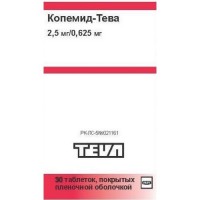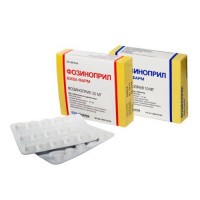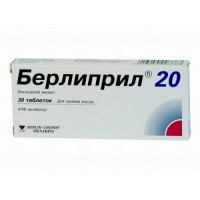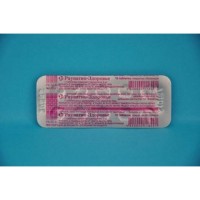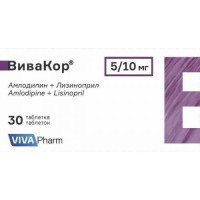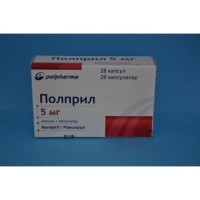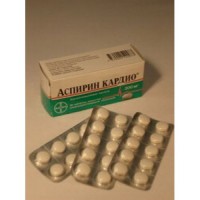Lerkamen® 28's 10 mg coated tablets
- $21.20
Out Of Stock
The instruction for medical use
of Леркамен® 10 medicine
the Trade name
Леркамен® 10
International unlicensed
name Lerkanidipin Lekarstvennaya
the Tablet form, coated 10 mg
Structure
One tablet contains
active agent - a lerkanidipin of a hydrochloride of 10 mg (it is equivalent to a lerkinidipin of 9.4 mg)
excipients
structure of a kernel: lactoses monohydrate, cellulose microcrystalline, sodium of starch glikolit (type A), K30 povidone, magnesium stearate
structure of a cover: Opadri OY-SR-6497: gipromelloza, talc, titan dioxide (E171), macrogoal 6000, ferrous oxide (E172).
The description
of the Tablet, coated yellow color, round biconvex shape, with risky on one party
Pharmacotherapeutic group
Blockers of slow calcium channels. Dihydropyridinic proizvodnyekod ATX C08CA13
the Pharmacological
Pharmacokinetics Lerkanidipin properties is completely soaked up after intake of 10 - 20 mg, and the maximum concentration in plasma, are reached approximately in 1.5 - 3 hours after reception.
Both enantiomer of a lerkanidipin show a similar profile of plasma concentration: time of achievement of the maximum concentration in plasma is identical, the maximum concentration in plasma and the area under kinetic curve (AUC) is on average 1.2 times higher for (S) - an enantiomer, and elimination half-life of two enantiomer is generally identical. Owing to high metabolism at the first passing through a liver the absolute bioavailability of the lerkanidipin applied orally at patients after meal is about 10%, at the same time it decreases up to 1/3 these values if drug is used at healthy volunteers on a hungry stomach.
The bioavailability after oral use of a lerkanidipin increases by 4 times if lerkanidipin is accepted no later than 2 hours after intake of greasy food. Therefore Леркамен® 10 it is necessary to accept to food.
Distribution in fabrics and bodies comes from plasma quickly and everywhere.
Extent of linking of a lerkanidipin with serum proteins exceeds 98%. As the content of proteins of plasma at patients with heavy degree of dysfunction of kidneys or a liver is reduced, the free fraction of medicine can be raised.
Lerkanidipin is extensively metabolized by CYP3A4 enzyme, initial medicine in urine and Calais is not found. It mainly turns into inactive metabolites, and about 50% of the accepted dose are removed with urine.
Elimination happens, generally by biotransformation.
The average value of elimination half-life is 8-10 hours, and therapeutic action continues within 24 hours owing to high extent of linking of medicine with a lipidic membrane. At repeated use the cumulation was not observed.
Oral use of a lerkanidipin results in plasma concentration which do not depend in direct ratio on the accepted dose (nonlinear kinetics). After reception of 10, 20 or 40 mg the observed maximum concentration in plasma had a ratio 1:3:8, and the areas under curves of dependence of concentration in plasma from time had a ratio 1:4:18 that indicates gradual saturation of metabolism at the first passing. Thus, the bioavailability increases with increase in a dosage.
The pharmacokinetic properties of a lerkanidipin observed at elderly patients and at patients with dysfunction of kidneys of weak or average degree or with an abnormal liver function of weak or average degree are similar and do not differ from pharmacokinetics of the general population of patients, patients with heavy degree have dysfunctions of kidneys or dializo-dependent patients of concentration of medicine had higher (about 70%). At patients with average or heavy degree of an abnormal liver function the system bioavailability of a lerkanidipin increases as drug, as a rule, is metabolized in a liver.
The pharmacodynamics
Lerkanidipin is an antagonist of calcium of dihydropyridinic group and inhibits transmembrane inflow of calcium to cardiac and smooth muscle cells. The mechanism of its antihypertensive action is caused by the direct relaxing action on unstriated muscles of vessels therefore the general peripheric resistance of vessels decreases. Despite short plasma elimination half-life, lerkanidipin possesses the prolonged antihypertensive action owing to its high coefficient of membrane division and lack of negative inotropic effect thanks to high vascular selectivity.
As the vazodilatation caused Леркаменом® 10 occurs gradually after the beginning of reception, acute hypotension with reflex tachycardia at hypertensive patients is observed seldom.
As in case of other asymmetric 1.4 dihydropyridines, antihypertensive action of a lerkanidipin is caused, mainly, by its (S) - an enantiomer.
Indications
- essential hypertensia weak both moderate severity
the Route of administration and doses
the Recommended dose at intake makes 10 mg once a day, at least in 15 minutes prior to food, the dose can be increased up to 20 mg depending on individual susceptibility of the patient.
Titling of a dose should be carried out gradually as there can pass about two weeks after the beginning of drug intake until the maximum antihypertensive action is shown.
On some patients whom did not check regarding use of only one antihypertensive drug lerkamen can make favorable impact if it is appointed in addition to therapy the medicine blocking a beta adrenoceptor (atenolol), therapies by diuretic (Hydrochlorthiazidum) or angiotensin-converting enzyme inhibitor (captopril or enalapril).
As the dependence curve 'a dose – response' has the plateau at the doses making 20-30 mg, the probability of increase in efficiency of treatment at higher doses is small while the risk of emergence of side effects can increase.
Use for elderly: though pharmacokinetic data and clinical experience say that when choosing a daily dosage the adjustment is not required, it is necessary to show extra care, starting treatment of elderly patients.
Use for children: as there is no clinical experience in the relation of patients more young than 18 years, use for children is not recommended now.
Use in dysfunction of kidneys or a liver: it is necessary to show extra care when begin treatment of patients with dysfunction of kidneys or a liver of weak or average degree. Though the recommended usually dose mode can normally be transferred by this subgroup of patients, a day it is necessary to approach increase in a dose up to 20 mg with care. Hypotensive effect of drug can amplify at patients with liver dysfunction, therefore, in these cases the correction of a dose can be required.
ÏÑÓ¬á¼Ñ¡® 10 it is not recommended to apply at patients with heavy degree of dysfunction of a liver or patients with heavy degree have dysfunctions of kidneys (glomerular filtration rate & lt, 30 ml/min.).
Side effects
Approximately at 1.8% of patients who were treated drug were observed side effects
Sometimes (≥1/1000 & lt, 1/100)
- a headache, dizziness
- heartbeat, tachycardia
- hyperaemia
- peripheral hypostases
Seldom (≥1/10000 & lt, 1/1000)
- drowsiness, stenocardia, tachycardia
- nausea, dyspepsia, diarrhea, an abdominal pain, vomiting
- rash
- myalgia
- a polyuria
- an asthenia, fatigue
- stenocardia
Very seldom (& lt, 1/10000)
- hypersensitivity, a faint
- a hyperplasia of gums, reversible increases in serum of level of transaminases of a liver, hypotonia, increase in frequency of urination, a stethalgia
- increase in frequency, duration or weight of attacks of stenocardia.
Some dihydropyridines can lead in rare instances ing of precardiac pains or to stenocardia.
Very seldom at the patients who already have stenocardia the increase in frequency, duration or weight of these attacks can be observed. In some cases the myocardial infarction can develop.
ÏÑÓ¬á¼Ñ¡® 10, most likely, has no adverse impact on sugar level in blood and lipids in serum.
Contraindications
- hypersensitivity to a lerkanidipin, drug components, other drugs from group of dihydropyridine
- the women of fertile age who are not using effective contraception
- obstruction of the vessels proceeding from a left ventricle of heart
- uncured stagnant heart failure
- unstable stenocardia
- heavy degree of dysfunction of a liver or kidneys
- the period which is 1 month after the postponed myocardial infarction
- intake of strong CYP3A4 inhibitors, cyclosporine, grapefruit juice
- pregnancy and the period of a lactation
Medicinal interactions
Леркамен® 10 is metabolized under the influence of CYP enzyme 3A4 and therefore, the inhibitors and inductors CYP 3A4 accepted together with lerkanidipiny can affect process of metabolism and elimination Леркамена® 10.
It is necessary to avoid co-administration Леркамена® 10 with CYP inhibitors 3A4 (as, for example, ketokonazol, itrakonazol, ritonavir, erythromycin, troleandomitsin).
Cyclosporine and Леркамен® 10 should not be accepted in common.
Both for Леркамена® 10, and for cyclosporine the increase in concentration in plasma as a result of combined use of these drugs is observed. Joint reception Леркамена® 10 with cyclosporine causes 3-fold increase in concentration Леркамена® 10 in plasma and increase in AUC value for cyclosporine for 21%.
ÏÑÓ¬á¼Ñ¡® 10 it is not necessary to wash down with grapefruit juice.
As well as other dihydropyridines, Леркамен® 10 shows special sensitivity to metabolism inhibition grapefruit juice, with increase as a result of it its system bioavailability and increase in hypotensive action.
When Леркамен® 10 it was appointed in a dose of 20 mg together with midazolam to orally elderly volunteers, absorption Леркамена® 10 increased (approximately by 40%), the speed of absorption decreased (tmax increased and made 3 hours instead of 1.75 hours). Concentration of midazolam at the same time did not change.
It is necessary to show care, when assigning Леркамена® 10 together with other CYP substrates 3A4, such as terfenadin, astemizol, with antiarrhytmic drugs of class III, such as Amiodaronum, kvinidin.
It is necessary to approach with care, co-administration Леркамена® 10 with inductors CYP 3A4, such as, anticonvulsive means (for example, Phenytoinum, carbamazepine) and rifampicin as hypotensive effect of drug in this connection control of arterial blood pressure is necessary can decrease.
At joint reception Леркамена® 10 with metoprololy, a β-blocker which eliminirutsya, mainly through a liver the bioavailability of a metoprolol at the same time does not change while the bioavailability Леркамена® 10 decreases by 50%. This effect probably occurs owing to reduction of the hepatic blood-groove caused by β-blockers and can therefore to meet at use of other drugs of this class. Therefore, Леркамен® 10 can without fear be appointed with β-adrenoceptor blocking drugs, but at the same time correction of a dose can be required.
The interaction research with fluoxetine (CYP inhibitor 2D6 and CYP 3A4) conducted on volunteers whose age was 65 ± 7 years (average value ± a standard deviation) showed lack of clinically significant changes of pharmacokinetics Леркамена® 10.
Joint appointment with Cimetidinum on 800 mg a day does not cause significant changes in concentration Леркамена® 10 in plasma, but at higher doses the care as the bioavailability and hypotensive action Леркамена® 10 can increase is required.
At simultaneous purpose of 20 mg to Леркамена® 10 patients who it is long accept β-methyldigoxin, pharmacokinetic interaction is not observed. At healthy volunteers who were treated digoxin, increase in Cmax value of digoxin on average by 33% after reception of 20 mg Леркамена® 10 on an empty stomach was noted while AUC value and renal clearance changed slightly. Patients who are at the same time treated digoxin and Леркаменом® 10 should be controlled carefully (to carry out frequent clinical control) on emergence of initial symptoms of intoxication of digoxin.
When Леркамена® 10 hydrochloride in a dose of 20 mg were accepted repeatedly together with 40 mg of a simvastatin, the AUC value for Леркамена® 10 changed slightly while the AUC value for a simvastatin increased by 56%, and the same value for its active metabolite of a β-oxyacid – for 28%. It is improbable that such changes are clinically significant. Interaction can be not expected if Леркамен® 10 accept in the mornings, and simvastatin – in the evenings, as shown for such drug
At joint reception of 20 mg Леркамена® 10 with warfarin of changes of pharmacokinetics of warfarin it was not observed.
ÏÑÓ¬á¼Ñ¡á® 10 without fear it was appointed together with diuretics and inhibitors of angiotensin-converting enzyme.
It is necessary to avoid alcohol intake as it can exponentiate vasodilating effect of antihypertensive drugs.
Special instructions
Extra care should be shown when Леркамен® 10 it is applied at patients with a sick sinus syndrome (if the pacemaker is not implanted). Though hemodynamic controlled researches did not reveal deterioration in ventricular function, the care is required also for patients with dysfunction of a left ventricle of heart. It is supposed that some quickly operating dihydropyridines can cause increase in risk of progressing of cardiovascular pathology in patients with coronary heart disease. Though Леркамен® 10 possesses the prolonged action, at these patients it is required to show care.
Some dihydropyridines can lead ing of atrial pains or attacks of stenocardia in rare instances. Very seldom at the patients who already have stenocardia can be observed increase in frequency, duration or weight of these attacks. In some cases the myocardial infarction can develop.
Use in dysfunction of kidneys or a liver: it is necessary to show extra care when begin treatment of patients with dysfunction of kidneys or a liver of weak or average degree. Though the dosages recommended usually can normally be transferred by this group of patients, a day it is necessary to approach increase in a dose up to 20 mg with care. Hypotensive effect of drug can amplify at patients with liver dysfunction, therefore, in these cases the correction of a dose can be required.
ÏÑÓ¬á¼Ñ¡® 10 it is not recommended to apply at patients with heavy degree of dysfunction of a liver or patients with heavy degree have dysfunctions of kidneys (glomerular filtration rate & lt, 30 ml/min.)
Patients to whom it is appointed Леркамен® 10, should avoid alcohol intake as it can exponentiate effect of vazodilatiruyushchy antihypertensive drugs.
The inductors CYP3A4, such as anticonvulsive means (for example, Phenytoinum, carbamazepine) and rifampicin, can reduce concentration Леркамена® 10 in plasma and therefore the efficiency of effect Леркамена® 10 can be had below expected.
The hereditary lactose intolerance, deficiency of Lapp-lactases enzyme, malabsorption of glucose galactose
contains In one tablet 30 mg of lactose therefore this drug is contraindicated to the patients longing deficiency of lactase, a galactosemia or disturbance of absorption of a glucose/galactose
Pregnancy and the period of a lactation
This for Леркамену® 10 show lack of teratogenic action on rats and rabbits, the reproductive ability at rats also did not worsen. Nevertheless, due to the lack of clinical experience of use during pregnancy and in the period of a lactation and as it was found that other compounds of dihydropyridine have teratogenic effect on animals, Леркамен® 10 it is not necessary to appoint Леркамена® 10 during pregnancy or to women of childbearing age, not using effective contraception. Owing to high lipophilicity Леркамена® 10, it is possible to expect it distribution in breast milk therefore it is not necessary to appoint it also to nursing mothers.
Features of influence of medicine on ability to run the vehicle or potentially dangerous mechanisms
Clinical experience of use Леркамена® 10 shows that deterioration in ability to run the vehicle or potentially dangerous mechanisms is improbable. However it is necessary to show care, in connection with a likelihood of development of such side effects as dizziness, an asthenia, fatigue and in rare instances, drowsiness.
Overdose
there Were three registered overdose cases at use Леркамена® 10: in a dose of 150 mg, 280 mg and 800 mg (in suicide attempt). In case of use of 150 mg Леркамена® 10 + alcohol (uncertain quantity) drowsiness was observed.
Treatment: gastric lavage, activated carbon. In case of use of 280 mg Леркамена® 10 + 5.6 mg of a moksonidin were observed the following symptoms: cardiogenic shock, heavy ischemia of a myocardium, moderate renal failure.
Treatment: cardiac glycoside, diuretics (furosemide), high doses of catecholamines, parenterally plasma substitutes. In case of use of 800 mg Леркамена® 10 vomiting and hypotension was observed.
Treatment: activated carbon, laxatives and intravenously - a dopamine. In all cases of overdose, an outcome for patients favorable.
As well as at other dihydropyridines, the overdose causes an excessive peripheral vazodilatation with noticeable hypotension and reflex tachycardia.
In case of heavy hypotension, bradycardia and a loss of consciousness the cardiovascular support with intravenous administration of atropine against bradycardia is necessary.
From the point of view of prolonged pharmacological effect of drug in case of overdose the observation of the cardiovascular status of such patients at least within 24 hours is necessary.
Information on assessment of efficiency of dialysis is absent.
As drug is high-lipophilic, it is the most probable that its concentration in plasma is not the parameter reflecting risk period duration, and dialysis can be inefficient.
A form of release and packing
On 7, 14 or 15 tablets in blister strip packaging from a film of the polyvinylchloride and printing aluminum foil varnished.
On 1 planimetric packing on 7 tablets, or on 1 or 2 planimetric packs on 14 tablets, or on 4 or 6 planimetric packs on 15 tablets together with the instruction for medical use in the state and Russian languages put in a pack from cardboard.
At a temperature not above 25 °C
to Store storage conditions out of children's reach!
3 years
not to use a period of storage after an expiration date.
Prescription status
According to the prescription
of Proizvoditel Berlin-Hemi AG (Menarini Group),
Glinikker Weg 125 12489 Berlin, Germany
According to the license
of the REKORDATI Owner of the Registration Certificate of Menarini International Opereyshnz the Village of Luxembourg. And., Luxembourg
the Address of the organization accepting in the territory of the Republic of Kazakhstan claims from consumers on quality of products (goods): Representative office of JSC Berlin-Hemi AG in RKNomer of phone number: +7 727 2446183, 2446184, 2446185 Fax number: +7 727 2446180 E-mail address:
Kazakhstan@berlin-chemie.com
of Леркамен® 10 medicine
the Trade name
Леркамен® 10
International unlicensed
name Lerkanidipin Lekarstvennaya
the Tablet form, coated 10 mg
Structure
One tablet contains
active agent - a lerkanidipin of a hydrochloride of 10 mg (it is equivalent to a lerkinidipin of 9.4 mg)
excipients
structure of a kernel: lactoses monohydrate, cellulose microcrystalline, sodium of starch glikolit (type A), K30 povidone, magnesium stearate
structure of a cover: Opadri OY-SR-6497: gipromelloza, talc, titan dioxide (E171), macrogoal 6000, ferrous oxide (E172).
The description
of the Tablet, coated yellow color, round biconvex shape, with risky on one party
Pharmacotherapeutic group
Blockers of slow calcium channels. Dihydropyridinic proizvodnyekod ATX C08CA13
the Pharmacological
Pharmacokinetics Lerkanidipin properties is completely soaked up after intake of 10 - 20 mg, and the maximum concentration in plasma, are reached approximately in 1.5 - 3 hours after reception.
Both enantiomer of a lerkanidipin show a similar profile of plasma concentration: time of achievement of the maximum concentration in plasma is identical, the maximum concentration in plasma and the area under kinetic curve (AUC) is on average 1.2 times higher for (S) - an enantiomer, and elimination half-life of two enantiomer is generally identical. Owing to high metabolism at the first passing through a liver the absolute bioavailability of the lerkanidipin applied orally at patients after meal is about 10%, at the same time it decreases up to 1/3 these values if drug is used at healthy volunteers on a hungry stomach.
The bioavailability after oral use of a lerkanidipin increases by 4 times if lerkanidipin is accepted no later than 2 hours after intake of greasy food. Therefore Леркамен® 10 it is necessary to accept to food.
Distribution in fabrics and bodies comes from plasma quickly and everywhere.
Extent of linking of a lerkanidipin with serum proteins exceeds 98%. As the content of proteins of plasma at patients with heavy degree of dysfunction of kidneys or a liver is reduced, the free fraction of medicine can be raised.
Lerkanidipin is extensively metabolized by CYP3A4 enzyme, initial medicine in urine and Calais is not found. It mainly turns into inactive metabolites, and about 50% of the accepted dose are removed with urine.
Elimination happens, generally by biotransformation.
The average value of elimination half-life is 8-10 hours, and therapeutic action continues within 24 hours owing to high extent of linking of medicine with a lipidic membrane. At repeated use the cumulation was not observed.
Oral use of a lerkanidipin results in plasma concentration which do not depend in direct ratio on the accepted dose (nonlinear kinetics). After reception of 10, 20 or 40 mg the observed maximum concentration in plasma had a ratio 1:3:8, and the areas under curves of dependence of concentration in plasma from time had a ratio 1:4:18 that indicates gradual saturation of metabolism at the first passing. Thus, the bioavailability increases with increase in a dosage.
The pharmacokinetic properties of a lerkanidipin observed at elderly patients and at patients with dysfunction of kidneys of weak or average degree or with an abnormal liver function of weak or average degree are similar and do not differ from pharmacokinetics of the general population of patients, patients with heavy degree have dysfunctions of kidneys or dializo-dependent patients of concentration of medicine had higher (about 70%). At patients with average or heavy degree of an abnormal liver function the system bioavailability of a lerkanidipin increases as drug, as a rule, is metabolized in a liver.
The pharmacodynamics
Lerkanidipin is an antagonist of calcium of dihydropyridinic group and inhibits transmembrane inflow of calcium to cardiac and smooth muscle cells. The mechanism of its antihypertensive action is caused by the direct relaxing action on unstriated muscles of vessels therefore the general peripheric resistance of vessels decreases. Despite short plasma elimination half-life, lerkanidipin possesses the prolonged antihypertensive action owing to its high coefficient of membrane division and lack of negative inotropic effect thanks to high vascular selectivity.
As the vazodilatation caused Леркаменом® 10 occurs gradually after the beginning of reception, acute hypotension with reflex tachycardia at hypertensive patients is observed seldom.
As in case of other asymmetric 1.4 dihydropyridines, antihypertensive action of a lerkanidipin is caused, mainly, by its (S) - an enantiomer.
Indications
- essential hypertensia weak both moderate severity
the Route of administration and doses
the Recommended dose at intake makes 10 mg once a day, at least in 15 minutes prior to food, the dose can be increased up to 20 mg depending on individual susceptibility of the patient.
Titling of a dose should be carried out gradually as there can pass about two weeks after the beginning of drug intake until the maximum antihypertensive action is shown.
On some patients whom did not check regarding use of only one antihypertensive drug lerkamen can make favorable impact if it is appointed in addition to therapy the medicine blocking a beta adrenoceptor (atenolol), therapies by diuretic (Hydrochlorthiazidum) or angiotensin-converting enzyme inhibitor (captopril or enalapril).
As the dependence curve 'a dose – response' has the plateau at the doses making 20-30 mg, the probability of increase in efficiency of treatment at higher doses is small while the risk of emergence of side effects can increase.
Use for elderly: though pharmacokinetic data and clinical experience say that when choosing a daily dosage the adjustment is not required, it is necessary to show extra care, starting treatment of elderly patients.
Use for children: as there is no clinical experience in the relation of patients more young than 18 years, use for children is not recommended now.
Use in dysfunction of kidneys or a liver: it is necessary to show extra care when begin treatment of patients with dysfunction of kidneys or a liver of weak or average degree. Though the recommended usually dose mode can normally be transferred by this subgroup of patients, a day it is necessary to approach increase in a dose up to 20 mg with care. Hypotensive effect of drug can amplify at patients with liver dysfunction, therefore, in these cases the correction of a dose can be required.
ÏÑÓ¬á¼Ñ¡® 10 it is not recommended to apply at patients with heavy degree of dysfunction of a liver or patients with heavy degree have dysfunctions of kidneys (glomerular filtration rate & lt, 30 ml/min.).
Side effects
Approximately at 1.8% of patients who were treated drug were observed side effects
Sometimes (≥1/1000 & lt, 1/100)
- a headache, dizziness
- heartbeat, tachycardia
- hyperaemia
- peripheral hypostases
Seldom (≥1/10000 & lt, 1/1000)
- drowsiness, stenocardia, tachycardia
- nausea, dyspepsia, diarrhea, an abdominal pain, vomiting
- rash
- myalgia
- a polyuria
- an asthenia, fatigue
- stenocardia
Very seldom (& lt, 1/10000)
- hypersensitivity, a faint
- a hyperplasia of gums, reversible increases in serum of level of transaminases of a liver, hypotonia, increase in frequency of urination, a stethalgia
- increase in frequency, duration or weight of attacks of stenocardia.
Some dihydropyridines can lead in rare instances ing of precardiac pains or to stenocardia.
Very seldom at the patients who already have stenocardia the increase in frequency, duration or weight of these attacks can be observed. In some cases the myocardial infarction can develop.
ÏÑÓ¬á¼Ñ¡® 10, most likely, has no adverse impact on sugar level in blood and lipids in serum.
Contraindications
- hypersensitivity to a lerkanidipin, drug components, other drugs from group of dihydropyridine
- the women of fertile age who are not using effective contraception
- obstruction of the vessels proceeding from a left ventricle of heart
- uncured stagnant heart failure
- unstable stenocardia
- heavy degree of dysfunction of a liver or kidneys
- the period which is 1 month after the postponed myocardial infarction
- intake of strong CYP3A4 inhibitors, cyclosporine, grapefruit juice
- pregnancy and the period of a lactation
Medicinal interactions
Леркамен® 10 is metabolized under the influence of CYP enzyme 3A4 and therefore, the inhibitors and inductors CYP 3A4 accepted together with lerkanidipiny can affect process of metabolism and elimination Леркамена® 10.
It is necessary to avoid co-administration Леркамена® 10 with CYP inhibitors 3A4 (as, for example, ketokonazol, itrakonazol, ritonavir, erythromycin, troleandomitsin).
Cyclosporine and Леркамен® 10 should not be accepted in common.
Both for Леркамена® 10, and for cyclosporine the increase in concentration in plasma as a result of combined use of these drugs is observed. Joint reception Леркамена® 10 with cyclosporine causes 3-fold increase in concentration Леркамена® 10 in plasma and increase in AUC value for cyclosporine for 21%.
ÏÑÓ¬á¼Ñ¡® 10 it is not necessary to wash down with grapefruit juice.
As well as other dihydropyridines, Леркамен® 10 shows special sensitivity to metabolism inhibition grapefruit juice, with increase as a result of it its system bioavailability and increase in hypotensive action.
When Леркамен® 10 it was appointed in a dose of 20 mg together with midazolam to orally elderly volunteers, absorption Леркамена® 10 increased (approximately by 40%), the speed of absorption decreased (tmax increased and made 3 hours instead of 1.75 hours). Concentration of midazolam at the same time did not change.
It is necessary to show care, when assigning Леркамена® 10 together with other CYP substrates 3A4, such as terfenadin, astemizol, with antiarrhytmic drugs of class III, such as Amiodaronum, kvinidin.
It is necessary to approach with care, co-administration Леркамена® 10 with inductors CYP 3A4, such as, anticonvulsive means (for example, Phenytoinum, carbamazepine) and rifampicin as hypotensive effect of drug in this connection control of arterial blood pressure is necessary can decrease.
At joint reception Леркамена® 10 with metoprololy, a β-blocker which eliminirutsya, mainly through a liver the bioavailability of a metoprolol at the same time does not change while the bioavailability Леркамена® 10 decreases by 50%. This effect probably occurs owing to reduction of the hepatic blood-groove caused by β-blockers and can therefore to meet at use of other drugs of this class. Therefore, Леркамен® 10 can without fear be appointed with β-adrenoceptor blocking drugs, but at the same time correction of a dose can be required.
The interaction research with fluoxetine (CYP inhibitor 2D6 and CYP 3A4) conducted on volunteers whose age was 65 ± 7 years (average value ± a standard deviation) showed lack of clinically significant changes of pharmacokinetics Леркамена® 10.
Joint appointment with Cimetidinum on 800 mg a day does not cause significant changes in concentration Леркамена® 10 in plasma, but at higher doses the care as the bioavailability and hypotensive action Леркамена® 10 can increase is required.
At simultaneous purpose of 20 mg to Леркамена® 10 patients who it is long accept β-methyldigoxin, pharmacokinetic interaction is not observed. At healthy volunteers who were treated digoxin, increase in Cmax value of digoxin on average by 33% after reception of 20 mg Леркамена® 10 on an empty stomach was noted while AUC value and renal clearance changed slightly. Patients who are at the same time treated digoxin and Леркаменом® 10 should be controlled carefully (to carry out frequent clinical control) on emergence of initial symptoms of intoxication of digoxin.
When Леркамена® 10 hydrochloride in a dose of 20 mg were accepted repeatedly together with 40 mg of a simvastatin, the AUC value for Леркамена® 10 changed slightly while the AUC value for a simvastatin increased by 56%, and the same value for its active metabolite of a β-oxyacid – for 28%. It is improbable that such changes are clinically significant. Interaction can be not expected if Леркамен® 10 accept in the mornings, and simvastatin – in the evenings, as shown for such drug
At joint reception of 20 mg Леркамена® 10 with warfarin of changes of pharmacokinetics of warfarin it was not observed.
ÏÑÓ¬á¼Ñ¡á® 10 without fear it was appointed together with diuretics and inhibitors of angiotensin-converting enzyme.
It is necessary to avoid alcohol intake as it can exponentiate vasodilating effect of antihypertensive drugs.
Special instructions
Extra care should be shown when Леркамен® 10 it is applied at patients with a sick sinus syndrome (if the pacemaker is not implanted). Though hemodynamic controlled researches did not reveal deterioration in ventricular function, the care is required also for patients with dysfunction of a left ventricle of heart. It is supposed that some quickly operating dihydropyridines can cause increase in risk of progressing of cardiovascular pathology in patients with coronary heart disease. Though Леркамен® 10 possesses the prolonged action, at these patients it is required to show care.
Some dihydropyridines can lead ing of atrial pains or attacks of stenocardia in rare instances. Very seldom at the patients who already have stenocardia can be observed increase in frequency, duration or weight of these attacks. In some cases the myocardial infarction can develop.
Use in dysfunction of kidneys or a liver: it is necessary to show extra care when begin treatment of patients with dysfunction of kidneys or a liver of weak or average degree. Though the dosages recommended usually can normally be transferred by this group of patients, a day it is necessary to approach increase in a dose up to 20 mg with care. Hypotensive effect of drug can amplify at patients with liver dysfunction, therefore, in these cases the correction of a dose can be required.
ÏÑÓ¬á¼Ñ¡® 10 it is not recommended to apply at patients with heavy degree of dysfunction of a liver or patients with heavy degree have dysfunctions of kidneys (glomerular filtration rate & lt, 30 ml/min.)
Patients to whom it is appointed Леркамен® 10, should avoid alcohol intake as it can exponentiate effect of vazodilatiruyushchy antihypertensive drugs.
The inductors CYP3A4, such as anticonvulsive means (for example, Phenytoinum, carbamazepine) and rifampicin, can reduce concentration Леркамена® 10 in plasma and therefore the efficiency of effect Леркамена® 10 can be had below expected.
The hereditary lactose intolerance, deficiency of Lapp-lactases enzyme, malabsorption of glucose galactose
contains In one tablet 30 mg of lactose therefore this drug is contraindicated to the patients longing deficiency of lactase, a galactosemia or disturbance of absorption of a glucose/galactose
Pregnancy and the period of a lactation
This for Леркамену® 10 show lack of teratogenic action on rats and rabbits, the reproductive ability at rats also did not worsen. Nevertheless, due to the lack of clinical experience of use during pregnancy and in the period of a lactation and as it was found that other compounds of dihydropyridine have teratogenic effect on animals, Леркамен® 10 it is not necessary to appoint Леркамена® 10 during pregnancy or to women of childbearing age, not using effective contraception. Owing to high lipophilicity Леркамена® 10, it is possible to expect it distribution in breast milk therefore it is not necessary to appoint it also to nursing mothers.
Features of influence of medicine on ability to run the vehicle or potentially dangerous mechanisms
Clinical experience of use Леркамена® 10 shows that deterioration in ability to run the vehicle or potentially dangerous mechanisms is improbable. However it is necessary to show care, in connection with a likelihood of development of such side effects as dizziness, an asthenia, fatigue and in rare instances, drowsiness.
Overdose
there Were three registered overdose cases at use Леркамена® 10: in a dose of 150 mg, 280 mg and 800 mg (in suicide attempt). In case of use of 150 mg Леркамена® 10 + alcohol (uncertain quantity) drowsiness was observed.
Treatment: gastric lavage, activated carbon. In case of use of 280 mg Леркамена® 10 + 5.6 mg of a moksonidin were observed the following symptoms: cardiogenic shock, heavy ischemia of a myocardium, moderate renal failure.
Treatment: cardiac glycoside, diuretics (furosemide), high doses of catecholamines, parenterally plasma substitutes. In case of use of 800 mg Леркамена® 10 vomiting and hypotension was observed.
Treatment: activated carbon, laxatives and intravenously - a dopamine. In all cases of overdose, an outcome for patients favorable.
As well as at other dihydropyridines, the overdose causes an excessive peripheral vazodilatation with noticeable hypotension and reflex tachycardia.
In case of heavy hypotension, bradycardia and a loss of consciousness the cardiovascular support with intravenous administration of atropine against bradycardia is necessary.
From the point of view of prolonged pharmacological effect of drug in case of overdose the observation of the cardiovascular status of such patients at least within 24 hours is necessary.
Information on assessment of efficiency of dialysis is absent.
As drug is high-lipophilic, it is the most probable that its concentration in plasma is not the parameter reflecting risk period duration, and dialysis can be inefficient.
A form of release and packing
On 7, 14 or 15 tablets in blister strip packaging from a film of the polyvinylchloride and printing aluminum foil varnished.
On 1 planimetric packing on 7 tablets, or on 1 or 2 planimetric packs on 14 tablets, or on 4 or 6 planimetric packs on 15 tablets together with the instruction for medical use in the state and Russian languages put in a pack from cardboard.
At a temperature not above 25 °C
to Store storage conditions out of children's reach!
3 years
not to use a period of storage after an expiration date.
Prescription status
According to the prescription
of Proizvoditel Berlin-Hemi AG (Menarini Group),
Glinikker Weg 125 12489 Berlin, Germany
According to the license
of the REKORDATI Owner of the Registration Certificate of Menarini International Opereyshnz the Village of Luxembourg. And., Luxembourg
the Address of the organization accepting in the territory of the Republic of Kazakhstan claims from consumers on quality of products (goods): Representative office of JSC Berlin-Hemi AG in RKNomer of phone number: +7 727 2446183, 2446184, 2446185 Fax number: +7 727 2446180 E-mail address:
Kazakhstan@berlin-chemie.com

